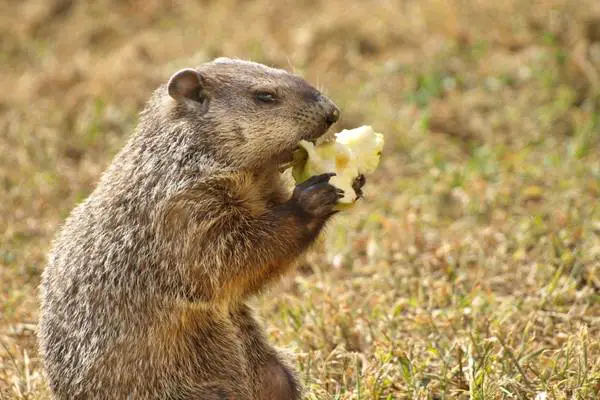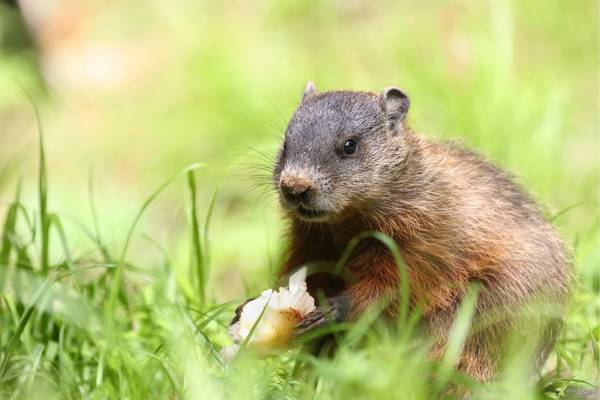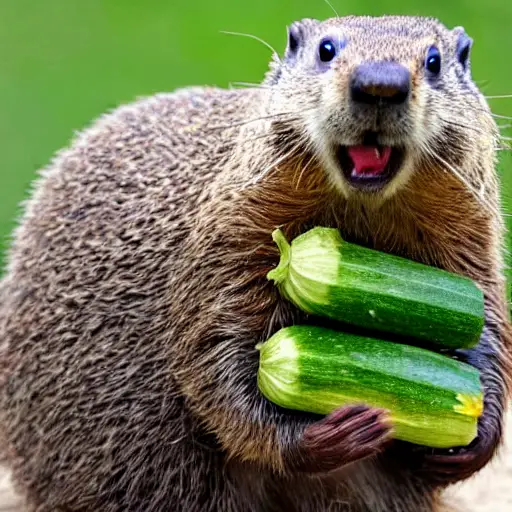If you’re like most backyard owners, you probably think of groundhogs as little creatures that burrow in your backyard and come out only on occasion to munch on your vegetables and fruits.
Yes, groundhogs do eat apples because they are primarily herbivores and they like the sweetness, water content and nutrients found in apples and other backyard fruits.
But did you know that these furry critters actually love apples? In fact, apples are a healthy snack for groundhogs!
Apples provide essential nutrients that groundhogs need. They’re a good source of fiber, vitamins, and minerals.
Why Do groundhogs eat Apples?
Apples are a healthy and nutritious food for groundhogs, providing them with essential nutrients that they need. Here’s why groundhogs like apples so much:
Groundhogs are rodents, and like all rodents, they have incisors that grow continuously throughout their lives. These teeth do not stop growing, so the groundhog will need to wear them down continuously in order to keep them the right length.

This means that they need to gnaw on hard objects, such as wood or apples, to keep their teeth from getting too long.
Apples are the perfect size and hardness for groundhogs to gnaw on, and they taste good too!
In addition to being a good source of food, apples also provide groundhogs with water.
Groundhogs live in burrows underground, and often do not have access to fresh water sources. By eating apples, groundhogs can stay hydrated without having to leave their homes.
Finally, apples are full of essential vitamins and minerals that groundhogs need to survive and stay healthy.
Groundhogs and Other Rodents Love Apples.
There are a few reasons why groundhogs (and other rodents) love apples so much.
Most rodents are mainly herbivores, and apples provide them with a lot of the nutrients they need, including carbohydrates, vitamins, and minerals.
Another reason groundhogs like apples is that they’re easy to eat, and are widely available in backyards all over North America.

They are also fairly large fruits compared to wild berries etc. and therefore apples are high in calories compared to what a rodent would encounter in the wild e.g. in the forest.
Apples are soft and have a lot of water in them, which makes them easy for groundhogs to chew and swallow. And because they’re small, groundhogs can eat a lot of them at once!
Finally, apples taste good! Groundhogs have very sensitive noses, and they can smell when an apple is ripe and ready to eat.
Ripe apples are sweet and juicy, and they make a delicious snack for any groundhog (or other rodent).
Apples Are a Healthy Snack for Groundhogs.
Apples are a great source of nutrition for groundhogs. They are packed with vitamins, minerals, and antioxidants that help keep groundhogs healthy.
apples provide essential nutrients that groundhogs need to stay healthy. Apples are a good source of fiber, vitamins C and K, and potassium.
These nutrients are important for keeping groundhogs’ digestive systems functioning properly, maintaining their fur coats healthy, and helping them to avoid diseases.
What Other Fruits might Groundhogs Eat?
When it comes to the dietary habits of groundhogs, apples are often the first thing that people think of.
Groundhogs are mostly vegetarians, and they are known to enjoy a variety of fruits, including apples. But just as humans have different preferences for certain fruits, so do groundhogs.
While groundhogs may enjoy apples as part of their diet, there are plenty of other fruits they would also eat.
One type of fruit that is particularly popular among groundhogs is berries.
Berries such as strawberries, blueberries, raspberries, and blackberries are all favorites for these small critters.

Not only taste good, but these sweet treats provide the groundhog with essential vitamins and minerals that help them stay healthy and fit.
Groundhogs also enjoy eating melon, such as watermelon, honeydew melon or cantaloupe. These juicy fruits offer plenty of water and fiber to keep a groundhog hydrated and its digestive system working properly.
In addition to berries and melons, groundhogs will happily munch on many types of vegetables.
Carrots make a great snack for these furry creatures; they not only offer nutrition but also provide a satisfying crunch factor that all groundhogs love!
Other vegetables like cucumbers, tomatoes and squash/zucchini are also popular among groundhogs.
Finally, don’t forget about nuts! Groundhogs love eating nuts like almonds or peanuts as an occasional treat.
Nuts are full of protein and healthy fats that help keep a groundhog’s body strong and healthy.
So while apples may be the go-to fruit when it comes to feeding your little buddy, there are plenty of other delicious fruits and vegetables available for your groundhog’s enjoyment too!
What to do if groundhogs eat my apples?
If you are tired of having groundhogs eating your fruits and vegetables in your yard, there are several options to get rid of them humanely.

So, instead of killing groundhogs, I would strongly recommend one of the very effective solutions listed below:
1. Ultrasonic Sound Emitters
Groundhogs and groundhogs, as well as other animals that may invade your garden, tend to have very good hearing. This means that loud or consistent noises will scare them away or at least shorten their visits significantly!
One of my favorite technologies to keep pests away from my backyard is these cool solar-powered ultrasonic sound emitters that you can buy right off Amazon! In my experience, they really work, and the solar panels on top save you the time and money of changing batteries all the time.
These are effective and passive instruments that will surely deter groundhogs from your yard. The number you need to place depends on the size of your yard and how deep the tunnels of the groundhogs are.
2. Motion-activated sprinklers
Like most animals, groundhogs hate surprises, and they will run away if suddenly sprayed with water. I like this solution because it is humane, simple, effective, and does not require much time to set up and there are many models to choose from.
The Havahart 5277 is a motion-activated sprinkler that is activated by the movement of animals up to 25 feet away and sprays them with a harmless water jet, frightening them off and keeping them at bay.
The included metal stake makes it easy to install in your backyard, and the sprinkler can be rotated 180 degrees for maximum coverage.
3. Using Lights and Reflections
Groundhogs are nocturnal animals so they may avoid areas that have bright lights. Motion-activated lights, sounds, and sprinklers may help prevent groundhogs from entering your yard.
Placing CDs or tin foil and mirrors around your yard is another cheap and effective way to create light reflections that blind and scare groundhogs.
This may sound a little old-fashioned but it still works! The reflective surface of CDs or tin foil drives groundhogs crazy and will make them seek away from your plants.
You can use old CDs you no longer need or aluminum trays from takeaway containers, just make sure they reflect light well.
If you have a lot of plants to protect this way, it may be a good idea to invest in some commercial mirrors or electronic light emitters like the ones shown above.
4. Build a Fence
The most obvious and practical solution to protecting your plants from groundhogs is to install a fence around the patch. A fence should be at least 2 feet tall and sunk in the ground about 8 inches.
The best fencing material for this purpose is a cattle panel or hog panel as they are very sturdy and can withstand even quadruped animals such as goats, cows, and deer. However, most chicken fencing types will do. This will be strong enough to stop them from getting through while still allowing for airflow and sunlight.
If you don’t like the idea of building a fence around your entire onion patch then you can try fencing off only the area that your onions, tomatoes, or zucchinis are in; this will at least keep some of the groundhogs or groundhogs away from them.
5. Using Hot Pepper Or Garlic Spray
This is a good way to protect your vegetable plants or decorative flowers against pests such as groundhogs, rabbits, deer, and groundhogs. It will also protect your backyard against the neighbor’s cat that thinks it is fine to use your vegetable garden as a toilet.
You only need about 1 tablespoon of crushed chili pepper and garlic along with 1 cup of vinegar per half a gallon of water.
Spray this mixture on any exposed parts of the plant until completely covered. Make sure you reapply whenever rain washes away the spray.
6. Use Rodent Deterring Companion Plants
Instead of making a tincture out of strongly smelling plants, you can also just plant the plants themselves!
Companion planting is a good way of deterring animals like groundhogs from your garden. You can plant strong-smelling plants such as garlic, basil, lavender, and chives around your favorite vegetables.
These plants will keep rodents like groundhogs, groundhogs, and mice away because they don’t like the smell of these and they mask the smell of the delicious plants.
7. Using Artificial Repellent
You can use some of the commercially available repellents to protecting your vegetable plants against groundhogs, groundhogs, and other rodents.
You will need to be careful when using these though because some of them can end up harming you and your pets if not applied properly. Some of the commercial groundhog repellents available include Shake-Away, Bonide Repels All, Critter Ridder, and Tom Cate Repellent.
8. Using a Scarecrow
Scarecrows may look a little funny in your garden, but they work surprisingly well. Just make sure your scarecrow is big and scary enough to deter groundhogs from getting anywhere near your tomatoes, zucchini, or backyard flowers! Also, you may need to replace the scarecrow every now and then as groundhogs will get used to it.
9. Using live traps
Using live traps to catch the groundhog and drive it away to somewhere safe, but far away, is perhaps the best option if you want to get completely rid of groundhogs in your yard!
You can make a trap yourself with some wire and ingenuity…
But, you can also just buy a live trap, like the sturdy metal ones shown here:
Conclusion
So, do groundhogs eat apples? It’s a valid question, and one that we will explore in this blog post.
Groundhogs are rodents, and like other rodents, they love apples. Apples are a healthy snack for groundhogs, providing essential nutrients that they need.
However, they have a very broad, mostly plant based, diet so they will eat all sorts of thing in your yard!
So if you’re wondering whether or not groundhogs eat apples, the answer is yes!





















